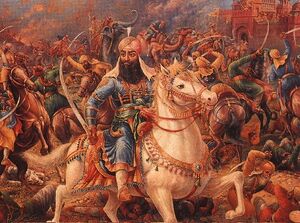Jassa Singh Ramgarhia

Jassa Singh Ramgarhia (जस्सा सिंह रामगढ़िया) (1723–1803) was a Bhambra clan jat. He was a prominent Sikh leader during the period of the Sikh Confederacy. He was the Commander of the Ramgarhia Misl (or Confederacy) from 1716 to 1801. He was a born leader of unprecedented qualities. His birth took place near Amritsar. He was 5 years old when Banda Singh Bahadur attained martyrdom at Delhi.
Jassa Singh had four brothers, Jai Singh, Khushal Singh, Mali Singh and Tara Singh. When his father Bhagwan died, he became head of the family.
He and his four brothers served in the Imperial Army under Khan Bahadhur. He was appointed a "Risaldar" (a Commander) by Adina Beg Khan. He and his brothers were given five villages as reward for their services. These villages were Valla, Verka, Sultanwind, Tung and Chabba.
Jassa Singh Ramgarhia established his Misl of Ramgarhia in and around Riarki area of Amritsar, Gurdaspur and Batala. He also fortified and constructed fort of Ram Rauni at Amritsar. His misal contained more than 5000 cavalry, always ready to fight Afghan and Mughal rulers. Sikhs at this time were in control of villages while Mughal administration was only effective in cities.
Sardar Jassa Singh Ramgarhia and his squad joined the army of the Commander of Jalandhar, named Adina Beg. Adina Beg was a cunning, treacherous, soft and sweet speaking mean person. Adina Beg on one hand would woo Sikhs to join him against Mughals on the other hand he had secret links with Afghans, while he drew his salary from Mughals. Jassa Singh Ramgarhia, being a simple minded person, trusted Adina Beg and joined his army.
The Sikhs gathered at Amritsar on the occasion of Diwali in 1748 A.D. When Mir Mannu came to know of the gathering of Sikhs, he sent his general with an army to blockade Amritsar and sent words to the Commander of Jalandhar, Adina Beg, to take his army to help his general in finishing the Sikhs. Adina Beg, not telling his Sikh army personnel, attacked fort of Ram Rauni. Five hundred Sikhs took shelter in fort of Ram Rauni and the rest moved to forests. The combined forces of Lahore and Jalandhar surrounded the fort. Sardar Jassa Singh Ramgarhia was in army who was in siege of fort, with his squad. Plight of his fellow Sikhs sorrounded in the fort of Ram Rauni was too much for him and his squad. One day he deserted the royal army and joined the Sikhs warriors inside the fort, with his squad. The Sikhs inside the fort did not surrender even after two months of siege.
Adina Beg felt the departure of the Jassa Singh Ramgarhia in this manner but could not do anything. Hearing the news of the second invasion of Abdali, Mir Mannu made peace with Sikhs and sanctioned an estate in Patti area for the livelihood. Thus, Jassa Singh Ramgarhia won the battle of Ram Rauni.
Abdali attacked India and Jassa Singh's squad along with other Sikh squad, was deployed in and around hills of Jammu, Pathonkot, to harass and snatch Abdali's baggage caravan. His 5000 cavalry soldiers harassed Abdali's Afghanis through Guerilla tactics of warfare that Abdali lost more soldiers to Sikhs in this type of warfare than his battle with Marthas at Panipat. Around same time Jassa Singh freed 2200 young Hindu women from Afghans who were being taken to the harems and bazaars of Kabul, Baghdad and Basra.
Next year Abdali returned to Punjab only to punish Sikhs. Mughals at this time were under his protectorate and small Mughal chieftains like, Nawab of Sirhind, and Sher Khan, Nawab of Malerkotla, as well as other tiny nawabs all over Punjab, helped Abdali to sorround Sikhs at a place near Malerkotla called Kup. Taruna Dal and Buddha Dal sorrounded women and children and fought head on for the first time with Abdali and his allies. Sikhs were outnumbered five to one (including women and chlidren on Sikh side). In this battle Sikhs lost about 30,000 warriors in a single day of battle and to this day it is called "The greater holocaust"., or "Wadda Ghalughara".
After this incident, Sikhs came out strong and in less than five years they defeated all Mughals and Afghan protectorate in between area of River Jamuna and River Indus. Jassa Singh's Ramgarhia Misl had played major part in this struggle. Later, Ranjit Singh incorporated Ramgarhia Misal into Sarkar Khalsa and thus a one unified Khalsa kingdom was created.
Gallery
-
Sultan-Ul-Kom Nawab Jassa Singh Alhuwalia,founder of Kapurthala and Alhuwalia dynasty. State:-Kapurthala, Gotra:-Sandhu.
References
जाट इतिहास:ठाकुर देशराज - Page 226-227
External Links
http://en.wikipedia.org/wiki/Jassa_Singh_Ramgarhia
http://www.sikh-history.com/sikhhist/warriors/ramgarhia.html
Back to The Rulers


